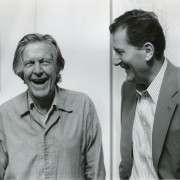|
Back
Slush from the Ice Age New York
Isaac Stern Auditorium, Carnegie Hall
10/22/2012 -
John Cage: Atlas Eclipticalis – Winter Music (Performed simultaneously)
Christian Marclay: Shuffle
Joseph Kubera, Ursula Oppens (Pianos)
The S.E.M. Ensemble, Petr Kotik (Conductor) 
J. Kubera, P. Kotik (© S.E.M. Ensemble)
Had cellphones been permitted in Carnegie Hall, I might have been tempted to dial the Suicide Hotline about halfway through John Cage’s Atlas Eclipticalis.
My confessedly untenable attitude was obviously the polar contrary to other members of the audience, whose frozen faces and non-moving, non-blinking eyes reminded me of the Xi’an army of ceramic soldiers. I am ready to surrender to their greater knowledge, more sensitive ears, that they are True Believers, and that they knew something I didn’t know.
A poet said “Pythagoras alone has seen beauty bare”, so perhaps they were Pythagoreans. Ergo, surrendering to their higher knowledge (and I am not being sarcastic), perhaps this review should not go further.
Before getting onto the piece itself, three premises. First, I do love John Cage. I met him when I was 14 years old, he was very impressive then. This year, the Centenary of his birth, I loved the performances of his Song Book (twice), his piano pieces (several recitalists), the Concert for Piano and Orchestra at the Guggenheim Museum. Even the most trivial piano pieces twinkling, gorgeous, funny, extravagant. Bewitching.
Second, I did my homework for Atlas Eclipticalis. I knew (without wishing to know too much) that Cage based it on an atlas of the stars, by a Czech astronomer. I knew that he had superimposed musical staves on the star charts. And knew that the brightness of the stars and the density of the starlight was translated into the size of the notes in the composition. And I learned that the conductor’s task was to determine the duration of each system, through signs, to the 80-plus piece orchestra and two pianos, with a duration to last from 40 minutes to two hours.
Third, this was a tour de force for composer, for conductor, for pianist and the S.E.M. Orchestra, To them, I offer heartfelt congratulations.
I, though, was at the bottom of the food chain. I was a listener. And the experience was agonizing. It was like the aural experience of traveling through a mythical swamp in an endless fog. No waves, at times a small watery ridge would hit the side of the board. Or an occasional a bit of debris would come floating by to break the monotony.
The “foggy swamp” was the bright-lit Carnegie. The wavelets were occasional notes, from solo instruments, a few rare moments when instruments played together, then trickling into silence.
As for the bits of interesting debris, that is the wrong word. Let’s say they were aural landmarks. A mighty THWACK on the drum, a fart-issimo blap from the trombone, tone clusters played by pianists Oppens and Kubera, sitting on opposite sides of the stage.
Then the glacial silence. The occasional instrumental tootle, like a post-nasal drip.
The emptiness, not of meditation but of boredom. The work was played “simultaneously” with Cage’s Winter Music, but I was in no position to separate warp from woof.

J. Cage, P. Kotik (1992) (© John Maggiotto)
I have every respect for conductor Petr Kotik. He not only was a colleague of John Cage, but he conducted many premieres (including this one), and his program note, while not explaining too much, gave a nice picture of John Cage himself.
Mr. Kotik didn’t exactly conduct the S.E.M. Ensemble, but his arms were like flagless semaphore signals, which obviously communicated to his group what they should do and how they should do it. Apparently, the orchestra had a huge percussion set, three harps, even more exotic instrumentation. But it was not what I would call an ensemble piece.
Had I done my own due diligence, I probably could have spoken to one of the players last week and asked for a decryption. But frankly, those cyphers, I felt, should be between the conductor and the musicians themselves.
Apologies to Christian Marclay, whose work, Shuffling came after the intermission. There was no possible way I could have sat in that auditorium any longer. Had the second half been a resurrected Furtwängler conducting Beethoven’s Ninth, yes. But nothing less than that.
Harry Rolnick
|